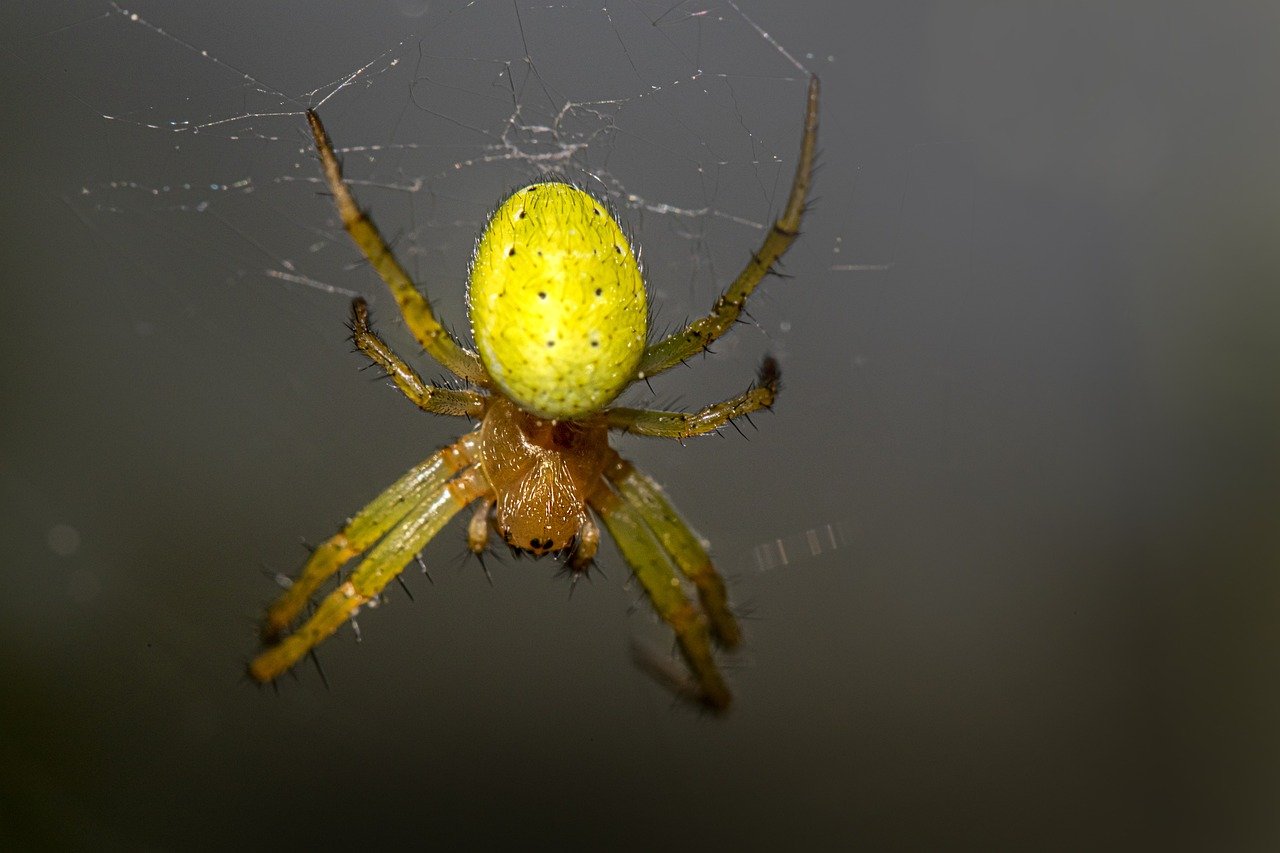The Cucumber Green Spider (Araniella cucurbitina) is a small and distinctive spider belonging to the family Araneidae, commonly known as orb-weavers. It is known for its vibrant coloration and unique web-building behavior.
Description
- Appearance:
- Size: The Cucumber Green Spider is relatively small, with a body length of about 3-6 millimeters (0.12-0.24 inches) and a leg span that can extend to about 10-15 millimeters (0.4-0.6 inches).
- Coloration:
- Body: The body of the spider is typically bright green, which provides it with excellent camouflage among foliage. This vibrant coloration can sometimes have a yellowish or whitish tinge.
- Pattern: The spider may have a few white or pale spots or stripes on its abdomen, adding to its distinctive appearance.
- Eyes: It has eight eyes arranged in two rows, which are characteristic of orb-weaving spiders.
Habitat
- Distribution: The Cucumber Green Spider is found across Europe and parts of Asia. It prefers temperate regions and is commonly observed in gardens, woodlands, and areas with abundant vegetation.
- Preferred Environment: It is typically found in areas with dense vegetation, including shrubs, hedges, and tall grasses. The spider often builds its web in these areas to capture flying insects.
Behavior and Ecology
- Web-Building:
- Web Type: The Cucumber Green Spider constructs a classic orb-shaped web, which is a characteristic feature of the Araneidae family. The web is typically constructed in a vertical plane and can be quite intricate.
- Function: The web is used to capture flying insects, which are attracted to the web by the spider’s silk and then immobilized by the spider.
- Diet:
- Prey: The spider primarily feeds on small flying insects such as gnats, flies, and small moths. It waits in the center of its web for prey to become entangled.
- Feeding Behavior: Once an insect is caught in the web, the spider quickly moves to subdue and wrap the prey in silk before consuming it.
- Reproduction:
- Eggs: The female spider lays eggs in a silk sac, which is often attached to vegetation or hidden among leaves.
- Development: The eggs hatch into spiderlings, which are initially very small and undergo several molts as they grow into adult spiders.
Conservation
- Status: The Cucumber Green Spider is generally not considered endangered. It is a common species in its habitat and can often be found in garden environments and natural areas with suitable vegetation.
- Conservation Efforts: Conservation efforts are typically focused on maintaining natural habitats with abundant vegetation and minimizing the use of pesticides, which can impact spider populations.
Observing Cucumber Green Spiders
- Best Times: They can be observed throughout the warmer months when they are most active, particularly during spring and summer.
- Watching Tips: Look for their intricate orb-shaped webs in areas with dense foliage or garden plants. The bright green coloration of the spider can make it well camouflaged against green leaves, so it may require a closer inspection to spot.
Interesting Facts
- Camouflage: The bright green coloration of the Cucumber Green Spider provides excellent camouflage among leaves and vegetation, helping it avoid predators and blend into its environment.
- Web Design: The orb-shaped web is a highly effective design for capturing flying insects and demonstrates the spider’s sophisticated silk-spinning capabilities.
Summary
The Cucumber Green Spider (Araniella cucurbitina) is a small but striking orb-weaving spider known for its vibrant green coloration and intricate web-building skills. Found in Europe and parts of Asia, it thrives in areas with abundant vegetation where it uses its web to capture prey. Its distinctive appearance and effective camouflage make it a notable species within the orb-weaver family.
Estonia’s diverse ecosystems, including forests, meadows, wetlands, and coastal areas, provide habitats for a variety of spider species. Here are some notable spiders you might encounter in Estonia:
Common Spiders:
- European Garden Spider (Araneus diadematus):
- Description: Known for its large, circular webs and distinctive white cross pattern on its abdomen.
- Habitat: Gardens, woodlands, and meadows.
- Common House Spider (Parasteatoda tepidariorum):
- Description: Builds irregular, messy webs in corners and crevices.
- Habitat: Inside homes, outbuildings.
- Norway Spider (Tegenaria domestica):
- Description: Creates funnel-shaped webs in corners and undisturbed areas.
- Habitat: Homes, barns, and forested areas.
- European Wolf Spider (Pardosa spp.):
- Description: Ground-dwelling spider with a wolf-like hunting style.
- Habitat: Meadows, grasslands, and forest floors.
Forest and Woodland Spiders:
- Crab Spider (Thomisidae):
- Description: Recognizable by their crab-like appearance, often found on flowers where they ambush prey.
- Habitat: Forest edges, meadows, and gardens.
- Jumping Spiders (Salticidae):
- Description: Small, agile hunters with large, forward-facing eyes.
- Habitat: Various environments including leaf litter, tree bark, and walls.
Specialized Spiders:
- Money Spider (Linyphiidae):
- Description: Tiny spiders that create small, intricate webs, often found in leaf litter.
- Habitat: Grasslands, woodlands, and meadows.
- Sheet Weavers (Linyphiidae):
- Description: Known for their small, horizontal sheet-like webs.
- Habitat: Grass, shrubs, and low vegetation.
Wetland and Aquatic Spiders:
- Water Spider (Argyroneta aquatica):
- Description: This spider creates a web underwater, using an air bubble to breathe.
- Habitat: Ponds, lakes, and slow-moving waters.
- Fishing Spider (Dolomedes fimbriatus):
- Description: Known for its ability to walk on water and hunt aquatic insects.
- Habitat: Near water bodies like ponds and marshes.
Rare or Less Common Spiders:
- Yellow Sac Spider (Cheiracanthium punctorium):
- Description: Notable for its bright yellow coloration and sac-like web.
- Habitat: Often found in gardens and grasslands.
- Garden Spider (Araneidae):
- Description: Various species that build orb-shaped webs in gardens.
- Habitat: Gardens and wooded areas.
Estonia’s spider fauna reflects its diverse habitats, with species adapted to different ecological niches. Whether in the forest, garden, or near water, there’s a rich variety of spiders to discover.
Views: 1800
Subscribe to the newsletter:
